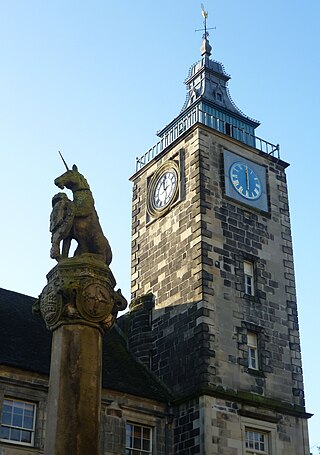
James Wilson, commonly known as "Purly Wilson," was a Scottish revolutionary, born in the parish of Avondale in Scotland, a prominent figure in the Radical movement seeking electoral reform. He was a weaver from the town of Strathaven in Lanarkshire, but as the Industrial Revolution affected the weaving trade he had to find alternative work.

The 21 Special Air Service Regiment (Artists) (Reserve), historically known as The Artists Rifles is a regiment of the Army Reserve. Its name is abbreviated to 21 SAS(R).

Bonnymuir was a moorland area near the town of Bonnybridge in Scotland. Today, it has mostly become either housing or farmland.

The Battle of Inverkeithing was fought on 20 July 1651 between an English army under John Lambert and a Scottish army led by James Holborne as part of an English invasion of Scotland. The battle was fought near the isthmus of the Ferry Peninsula, to the south of Inverkeithing, after which it is named.

The 51st Highland Volunteers is a battalion in the British Army's Army Reserve or reserve force in the Scottish Highlands, forming the 7th Battalion of the Royal Regiment of Scotland, also known as 7 SCOTS. It is one of two Reserve battalions in the Royal Regiment of Scotland, along with 52nd Lowland, a similar unit located in the Scottish Lowlands.

James Kelman is a Scottish novelist, short story writer, playwright and essayist. His fiction and short stories feature accounts of internal mental processes of usually, but not exclusively, working class narrators and their labyrinthine struggles with authority or social interactions, mostly set in his home city of Glasgow. Frequently employing stream of consciousness experimentation, Kelman's stories typically feature "an atmosphere of gnarling paranoia, imprisoned minimalism, the boredom of survival.".

The Radical War, also known as the Scottish Insurrection of 1820, was a week of strikes and unrest in Scotland, a culmination of Radical demands for reform in the United Kingdom of Great Britain and Ireland which had become prominent in the early years of the French Revolution, but had then been repressed during the long Napoleonic Wars.

Andrew Hardie was second-in-command of the Radical Forces who marched on Scotland's Carron Ironworks at Bonnymuir near Falkirk in the "Radical War" of 1820.
Events from the year 1820 in the United Kingdom. This year sees a change of monarch after a nine-year Regency.

The 44th Kievskaya of the Red Banner Rifle Division of Nikolay Shchors, or 44th Kievskaya for short, was an elite military formation of the Soviet Union. Created during the beginnings of the Russian Civil War. It was destroyed during the Winter War, after being ordered to help the 163rd Rifle Division break a Finnish siege on the Raate road as part of the Special Rifle Corps 9th Army, together with the 54th Rifle Division. Afterwards it was levied and dissolved multiple times throughout the 40s and 50s until its final dissolution in 1959.

The Order of the Red Banner Southern Military District is a military district of Russia.
The 87th Rifle Division was an infantry division of the Red Army, active before, during the Second World War and afterwards.

The 308th Rifle Division was a rifle division of the Soviet Red Army during World War II. The division was formed three separate times during the course of the war.
The 79th Guards Rifle Division was an infantry division of the Red Army during World War II.
The 22nd Motor Rifle Division named for Atamyrat Niyazov is a division of the Turkmenistan Ground Forces. It traces its history to the 344th Rifle Division, an infantry division of the Red Army and the Soviet Ground Forces during World War II and the Cold War.
Events from the year 1820 in Scotland.
The 57th Red Banner Ural-Khingan Rifle Division was an infantry division of the Red Army and the Soviet Army.
Colonel Sir George Murray Home Stirling, 9th Baronet CBE DSO was a Scottish British Army officer who was Lord Lieutenant of Stirlingshire from 1936 until 1949.

Stirling Tolbooth is a municipal building in Broad Street, Stirling, Scotland. The structure, which was the original meeting place of Stirling Burgh Council, is a Category A listed building.
This is the order of battle for the Russian invasion of Ukraine. It should not be considered complete; up-to-date; nor fully accurate, being based on open-source press reporting.











